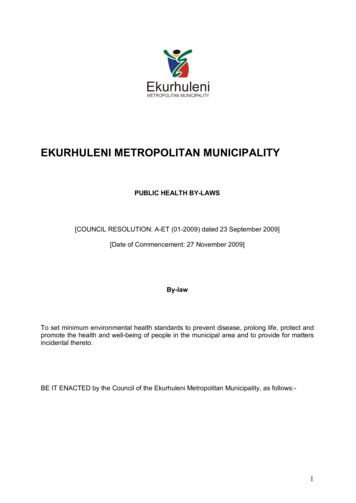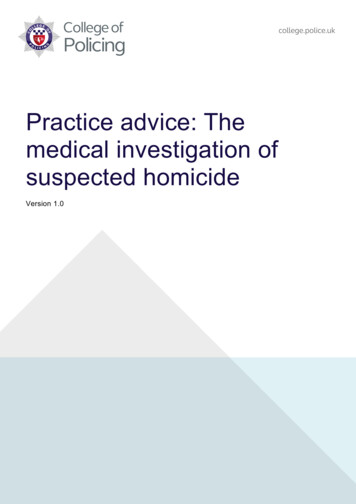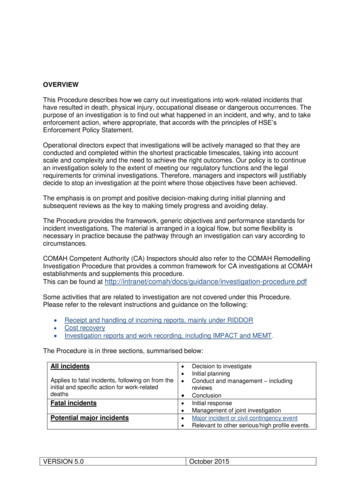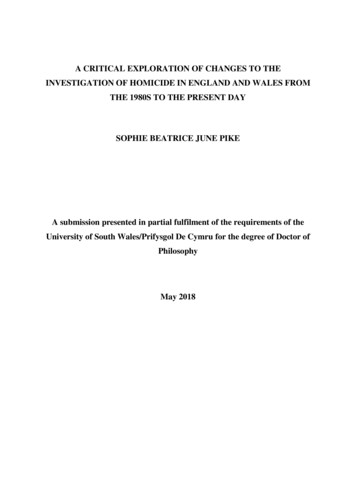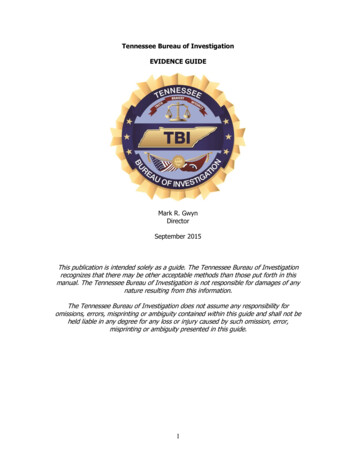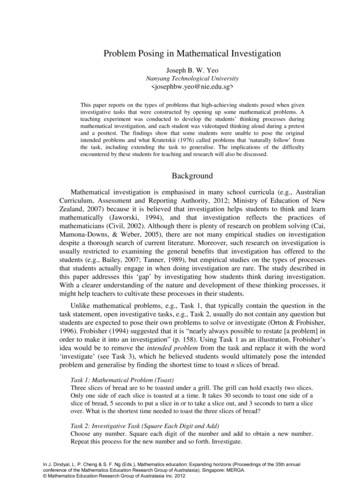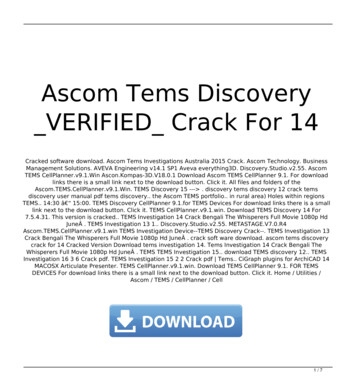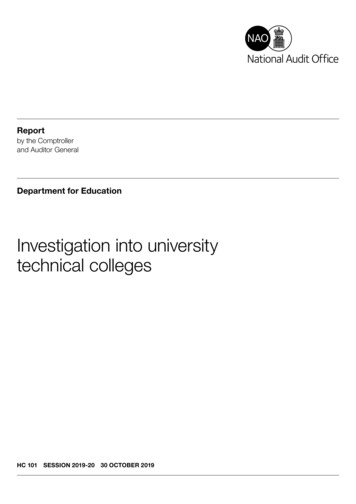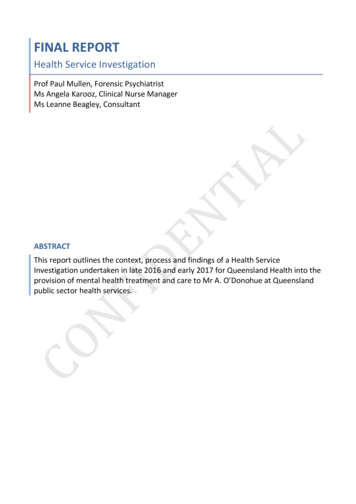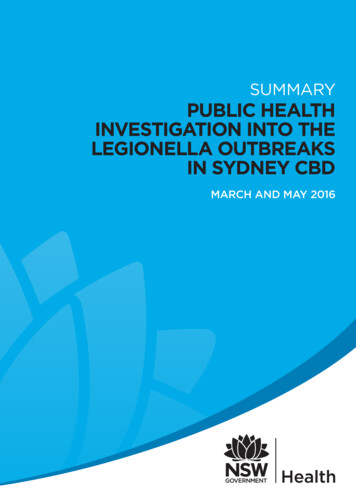
Transcription
SUMMARYPUBLIC HEALTHINVESTIGATION INTO THELEGIONELLA OUTBREAKSIN SYDNEY CBDMARCH AND MAY 2016
AUTHORSErin Griffiths, Robin Gilmour, Matthew Carlin, Sheena Adamson,Verlaine Timms, Sharon Chen, Vitali Sintchenko, Anna Smith, BradleyPope, Mark Ferson, Ben Scalley, Vicky Sheppeard, Jeremy McAnultyACKNOWLEDGEMENTSInfectious diseases and environmental health staff of South EasternSydney, Sydney, Western Sydney, Northern Sydney, Illawarra, and SouthWestern Sydney Public Health Units; NSW Health Public Health Networkenvironmental health officersDenise Read, Azmeena Kelly, Peter Harding and environmental healthofficers, City of SydneyNeisha Jeoffreys and Peter Howard of Centre for Infectious DiseasesMicrobiology – Public Health, and scientists from General MicrobiologyLaboratory, Centre for Infectious Diseases Microbiology – LaboratoryServices, Institute for Clinical Pathology and Medical Research, PathologyWestStaff of Legionella Reference Laboratory, Forensic and AnalyticalScience Services, NSW Health PathologyInfectious diseases staff of Metro South Public Health Unit, QueenslandInfectious diseases staff of Health Protection & Emergency ManagementBranch, Victorian Department of Health & Human ServicesMel Irwin and staff of Public Health Real-Time Emergency DepartmentSurveillance System, NSW Ministry of HealthNSW MINISTRY OF HEALTH73 Miller StreetNORTH SYDNEY NSW 2060Tel. (02) 9391 9000Fax. (02) 9391 9101TTY. (02) 9391 9900www.health.nsw.gov.auThis work is copyright. It may be reproduced in whole orin part for study or training purposes subject to the inclusionof an acknowledgement of the source. It may not be reproducedfor commercial usage or sale. Reproduction for purposesother than those indicated above requires written permissionfrom the NSW Ministry of Health. NSW Health 2016SHPN (CHP) 160481ISBN 978-1-76000-544-3 (print)ISBN 978-1-76000-545-0 (online)Further copies of this document can be downloadedfrom the NSW Health website www.health.nsw.gov.auNovember 2016
cussuion.8Conclusions and outcomes.9Appendix.10Legionella outbreaks in Sydney CBD NSW HEALTH PAGE 1
SummaryBackgroundThis report summarises the findings of publichealth investigations into Legionella outbreaks inSydney CBD, March and May 2016. The reportoutlines public health actions, case identification,environmental investigations, testing, results andactions taken. The investigation involved theMinistry of Health, Health Protection NSW, severalNSW public health units, the City of Sydney,Forensic and Analytic Science Services, and theCentre for Infectious Diseases Microbiology. Forthe first time in NSW whole genome sequencingwas used in a Legionella investigation.Epidemiological, environmental and laboratoryinvestigations determined that 13 people and twocooling towers shared a common strain ofLegionella, although the actual source of thehuman cases cannot be proven.The Sydney CBD is approximately 12.3km2 and onany one day there are an estimated 610,000visitors to the area on top of a resident populationof approximately 205,000 people (City of Sydney).The City of Sydney Council has approximately1200 registered cooling towers within this area.Legionnaires’ disease is an infection caused by oneof a number of bacteria of the genus Legionellacharacterised by fever, pneumonia, and muscleaches. It is notifiable by laboratories under theNSW Public Health Act 2010. Symptoms developbetween 2 – 10 days after exposure to the bacteria.People with significant underlying healthconditions and people who smoke are more likelyto develop Legionnaires’ disease after exposure tothe bacteria.The most common cause of Legionnaires’ diseasenotified in NSW is Legionella pneumophilaserogroup 1 (LP1). LP1 is commonly found in water,and can be spread when contaminated water isaerosolised, and then inhaled by people. Thisdisease is not transmitted from human to human.The Public Health Act and Public Health Regulation2012 set out the regulatory requirements for“regulated systems”, which are the systems thatare most susceptible to contamination by L.pneumophila. Regulated systems include airhandling systems, hot water systems, humidifyingsystems, warm water systems and water coolingsystems. A water cooling system includes a watercooling tower. Each local government authoritymaintains a register of regulated systems within itslocal area.However, L. pneumophila can also colonise otherwater systems subject to aerosolisation such asdecorative fountains. These are not subject toregulation under the Public Health Act as they areonly rarely identified as a cause of Legionnaires’disease, however in the context of an outbreak allpotential water sources are investigated.Following the notification of four cases ofLegionnaires’ disease on March 7 and 8, NSWHealth initiated a comprehensive investigation andresponse. Here we report on the cases identified inthis outbreak, the response, and the subsequentoutbreak in May 2016.PAGE 2 NSW HEALTH Legionella outbreaks in Sydney CBD
MethodsMarch outbreakResponse coordination On 9 March 2016, the public health emergencyoperations centre (PHEOC) and the IncidentControl System (ICS) was activated, and anincident management team was established. A field team consisting of approximately 20environmental health officers from City ofSydney, Health Protection NSW and NSW publichealth units were deployed to inspect andsample all cooling towers as well as otherpotential Legionella sources in the investigationarea. Coordination of human and environmentallaboratory testing between primary public andprivate laboratories, the Centre for InfectiousDiseases & Microbiology Laboratory Services(CIDMLS), at the Institute of Clinical Pathologyand Medical Research (ICPMR), Pathology Westand the Legionella Reference Laboratory at NSWForensic and Analytical Science Service (FASS)was activated. Daily incident management team teleconferenceswere held at 9am and 4pm Daily media statements were issued from theMinistry of Health SITREPs were produced and disseminated daily(a daily SITREP is a report which summarisescases, laboratory findings, exposure siteinspections and planned actions). Correspondence was issued to all cooling toweroperators in the CBD requesting they inspectand maintain their plants.Epidemiological investigationExposures of all Legionnaires’ cases notified fromlate December 2015 to March 2016 were reviewedand cases reinterviewed if required. All publichealth units were notified and asked to keep indaily contact with their laboratories to ensuretimely identification of new cases. Active casesurveillance was carried out by the relevant publichealth units and any new notifications wereinterviewed as a matter of priority.Clinicians, emergency departments, intensive careunits, general practitioners and pathologylaboratories were issued alerts about the outbreakand requested that appropriate testing beundertaken for suspected cases. Alerts to otherjurisdictions were disseminated due to thepossibility of interstate and international visitors.The NSW Health Public Health Real-TimeEmergency Department Surveillance System(PHREDSS) was utilised to monitor emergencydepartment presentations and admissionsretrospectively and prospectively for peoplepresenting with pneumonia-like illness.Environmental investigationThe environmental investigations involved physicalinspections of building cooling towers as well asunregulated sources, such as water fountainswithin defined areas of the Sydney CBD in order toidentify and sample possible sources of L.pneumophila. Other regulated systems, such aswarm water systems were not inspected asexposures related to such systems occur insidebuildings, and there was no indication that anysingle building had been visited by more than onecase. Hence the investigation focussed onLegionella sources that could contaminate theoutdoor environment. The investigation areas weredetermined on the basis of reviewing themovements of the cases and defining an area ofcommon outdoor exposure between these cases.The investigations were jointly conducted by theCity of Sydney Council and NSW Health (includinglocal health district public health units).The City of Sydney Council maintains the registerof regulated systems within the Sydney CBD andthis was used to identify known regulated systemswithin the investigation areas. Water treatmentcompanies who undertake the regular maintenanceand testing of cooling towers were also contactedand asked to carry out rapid cleaning anddisinfection of those cooling towers they werecontracted to manage. Concurrently, historicalinformation held on the City of Sydney register wasalso reviewed to ascertain if there were anyproblematic towers or systems that needed to beprioritised for inspection during the environmentalinvestigation.Legionella outbreaks in Sydney CBD NSW HEALTH PAGE 3
Teams of environmental health officers (EHOs)undertook inspections of the cooling towers,including obtaining samples and reviewingmaintenance records where available. Inconjunction with the City of Sydney a review ofsatellite imagery was also undertaken in anattempt to identify potential unregistered coolingtowers and other potential sources fromunregulated sites. One team was re-deployed toidentify and inspect potential unregistered towers,as well as unregulated sources, such as decorativewater fountains. Visibly unclean cooling towerswere issued with immediate orders to clean anddisinfect their systems. As the laboratory resultsbecame available appropriate notices andprohibition orders were issued to owners ofcooling towers whose systems tested positive(Appendix 3.1).The environmental investigation began on 9 March2016 and focused on a 1.56km2 investigation areawhich was subsequently expanded by a further1.32km2 on the basis of case exposures (Figure 1).The environmental response teams undertook riskbased inspection and sampling of air conditioningsystem cooling towers starting from Market andGeorge Streets bounded by the area Clarence,King, Park and Pitt Streets (Figure 1). Initially theCity of Sydney identified 17 high risk, 28 mediumrisk and 20 low risk regulated systems within thisarea. Risk is determined by a system’s past testinghistory and whether or not it is located in an areaof high pedestrian traffic density. Further to this,49 potential unregistered systems were identifiedby satellite imagery and were inspected (andtested if verified to be an operating cooling tower)although all bar a few were found to be no longerin use.On 11 March 2016 through additional examinationof cases' movements in and around the city it wasdecided to extend the search area to the east, upto and including Elizabeth Street. Therefore thearea under investigation was bound by Clarence,King, Park and Elizabeth Streets. A further 60registered towers and no unregistered towers wereidentified in this area.PAGE 4 NSW HEALTH Legionella outbreaks in Sydney CBDOn 14 March 2016 with addition of informationfrom new cases it was decided to extend thesearch area south to include premises up to andincluding Bathurst Street. The area was now boundby Kent, King, Elizabeth and Bathurst Streets(Figure 1). A further 23 registered systems and nounregistered towers were identified in this area.As of 15 March 2016 the environmental responseteam completed all testing within the area underinvestigation. In total 199 samples from registeredand unregistered systems were sent for analysis atthe FASS laboratory.Laboratory investigation – patientsLegionnaires’ disease is difficult to distinguish fromother types of pneumonia on the basis of patientsymptoms alone. Chest X-rays help to diagnosepneumonia but the diagnosis of Legionnaires’disease requires special laboratory tests.To confirm cases of L. pneumophila during theoutbreaks required:1) a positive urinary antigen test for LP1 which isavailable in local laboratories, or2) a positive Legionella culture from sputum orbronchial washings.To centralise testing for the outbreaks, laboratorieswere requested in an alert email to refer all sputumand bronchial washing samples from patientssuspected to have Legionnaires’ disease toCIDMLS, ICPMR for Legionella culture andserogrouping.At the time of the outbreaks CIDMLS, ICPMR wereevaluating a new multiplex polymerase chainreaction (PCR) test for Legionella spp., LP1 andother Legionella which is highly sensitive andspecific, has a more rapid turnaround time thanculture methods, and is particularly useful asLegionella is difficult to isolate in culture. Allrespiratory specimens received by CIDMLS, ICPMRfor Legionella culture were also tested by the PCR.All Legionella culture isolates obtained frompatients during the outbreaks and identified as LP1were characterised by whole genome sequencing(WGS), and compared with the environmentalisolates, to determine the relatedness of theorganisms as an indicator of a possible commonsource.
Laboratory investigation – environmentalEpidemiological investigationAll environmental water samples were referred tothe Legionella Reference Laboratory at NSWForensic and Analytical Science Service (FASS) fortesting. The samples were analysed usingmicrobiological cultural techniques. Negativeresults are reported as 10 colony forming unitsper millilitre (cfu/mL) (limit of detection of themethod). Results 10 and 100cfu/mL occur notinfrequently and may represent ineffectivemaintenance practices.All public health units were notified and asked tokeep in daily contact with their laboratories toensure timely identification of new cases. Activecase surveillance was carried out by the relevantpublic health units and any patients newly notifiedwith LP1 were interviewed as a matter of priority.Clinicians, emergency departments, intensive careunits and pathology laboratories were issued alertsabout the outbreak and requested that appropriatetesting be undertaken for suspected cases.Although there is little evidence at what level asystem may become a risk to public health, levelsgreater than or equal to 100 cfu/mL areconsidered potentially sources of infection.Presumptive results were available 1-2 days prior tofinal results, allowing earlier intervention.No alert was sent to general practitioners as it wasfelt that they were still acting on the previous alertsent in March. An alert to other jurisdictions wasdisseminated due to the possibility of interstateand international visitors.All environmental isolates of LP1 were forwardedto CIDMLS, ICPMR for whole genome sequencing(WGS) analysis.A timeline of the March outbreak is in Appendix 1.1.May outbreakResponse Coordination A field team consisting of approximately 20environmental health officers from City ofSydney, Health Protection NSW and NSW publichealth units were deployed to inspect andsample all cooling towers as well as otherpotential Legionella sources in the investigationarea. Coordination of human and environmentallaboratory testing between primary public andprivate laboratories, the Centre for InfectiousDiseases & Microbiology Laboratory Services(CIDMLS), at the Institute of Clinical Pathologyand Medical Research (ICPMR), Pathology Westand the Legionella Reference Laboratory at NSWForensic and Analytical Science Service (FASS)was reactivated. Incident management team teleconferenceswere held daily with minutes and responseactions recorded. Daily media statements were issued from theMinistry of Health Correspondence was issued to all cooling toweroperators in the CBD requesting they inspectand maintain their plants.Environmental investigationThe reported exposures of the cases indicated asearch area of 1.58km2 to the immediate north ofthe investigation area from the March outbreak.On the morning of 4 May 2016 the environmentalresponse teams undertook risk-based inspectionand sampling of air conditioning system coolingtowers bounded by the area Margaret, George,King and Kent Streets (Figure 2). Based onadditional information from case movements, itwas decided to extend this area to include the areabound by Pitt Street, George Street, King Streetand Curtin Place (which is in line with MargaretStreet) on May 5.Samples were taken from 87 registered coolingtowers in the area of interest. Additionally a YorkStreet tower was retested as this tower returned apositive result from the March testing and anothertwo cooling systems located in George Street weretested as a result of recent positive results forLegionella (not LP1).Teams of EHOs collected 130 environmentalsamples over a period of five days.Laboratory investigations – patient andenvironmentalLaboratory methods were as described for theMarch outbreak.A timeline of the May outbreak is in Appendix 1.2.Legionella outbreaks in Sydney CBD NSW HEALTH PAGE 5
ResultsMarch outbreakEpidemiological investigation– see Appendix 2.1On 7 March the Northern Sydney Local HealthDistrict Public Health Unit (NSLHD PHU) wasnotified about a male in his 60’s with confirmedLP1 (Case 1). The next afternoon (8 March 2016)the South Eastern Sydney Local Health DistrictPublic Health Unit (SESLHD PHU) received twonotifications of LP1 in a male resident in his 30’s(Case 2) and a male resident in his 60’s (Case 3).On the same day Queensland Health (QLD Health)notified the NSW Health Protection CommunicableDiseases Branch (CDB) of a confirmed LP1infection in a male tourist in his 60’s who hadstayed in the Sydney CBD during his incubationperiod and then travelled to Queensland (Case 4).Information obtained by the PHUs and QLD Healthrevealed all four cases had spent considerable timein the Sydney CBD around Town Hall, Market/George/Druitt/Sussex Streets during theirincubation periods.On 9 March 2016 as a result of a review of thecases notified previously to NSW Health, cases 5and 6 were identified. Case 5, a male resident in his40’s, had visited several CBD locations includingLiverpool Street, Criterion Hotel (Pitt and Parkstreets), Town Hall Station/Square and had walkeddown York Street in his incubation period inFebruary. Additionally a case notified in lateDecember 2015, a male resident in his 80’s, hadexposures around Town Hall station and the CityTattersalls Club in Pitt Street (Case 6).On 11 March 2016 cases 7 and 8 were reported bythe Western Sydney Local Health District PublicHealth Unit (WSLHD PHU): case 7, a male in his50’s reported exposures between Chinatown toTown Hall and also walked from Central Station toGoulburn Street. Case 8, a male resident in his 40’scaught a train at Central Station.PAGE 6 NSW HEALTH Legionella outbreaks in Sydney CBDOn 13 March 2016 a ninth and final case wasreported by NSLHD PHU: a male resident in his80’s, whose family reported him visiting GeorgeStreet and Castlereagh Street as well as Pitt StreetSydney. This person died in March 2016.The pneumonia presentations and admissionsreported through PHREDSS identified 61 possiblecases in people aged 35-64 years for the weekending 8 March 2016. All of these people werefollowed up by the local PHU and were either oneof the known cases (2), had a negative result forLP1 (56), or had a positive result for LP1 (3 cases)but had not gone into the CBD.Environmental investigation– see Appendix 3.1.Samples from the regulated systems of sevenpremises (ten samples) had 100 cfu/mL or greaterof LP1 grow on culture, including one with anexcessively high count of 2500 cfu/mL. Samplesfrom two other positive towers had 10 cfu/mLgrowth of LP1.As a result of inspections and laboratory findings,the following notices and orders were issued underthe Public Health Act: One Prohibition Order – for elevated cfu/mLlevels Three Section 33 Notices – for visibly uncleantowers Three Improvement Notices – for elevated cfu/mL levels Seven warning letters – Issued by City of Sydneyfor minor non-conformancesLaboratory investigationSix patient samples were positive for Legionellapneumophila serogroup 1 (LP1) by PCR. Of these,culture was successful for samples from threepatients, cases 2, 8 and 9.Whole genome sequencing results were availableon April 6 and showed that isolates from twopatients (cases 2 and 9) were closely geneticallyrelated, and that the isolate from the third patient(case 8) was distinctly different from the othertwo.
This patient had only been to Central Station, andthus epidemiologically and genomically was asporadic case not linked to the outbreak.Whole genome sequencing on the environmentalisolates found that all were distinct from thepatient samples, that is, none were likely to beresponsible for the human cases.May outbreakEpidemiological investigation– see Appendix 2.2On 28 April 2016, NSLHD PHU received notificationof a male resident in his 80’s with confirmed LP1(case 1). This man reported North Sydneyexposures and also daily visits to Clarence Street inthe CBD.On 3 May 2016, two cases of LP1 were notified tothe SESLHD PHU and WSLHD PHU. Case 2, afemale resident in her 30’s reported that sheworked in the CBD and would walk from MartinPlace down Erskine Street and along Shelley Streeteach business day during her incubation period.Case 3 a female resident in her 30’s, worked in theCBD and walked from Wynyard Station alongGeorge Street each day.On 6 May 2016, case 4 was notified to SydneyLocal Health District Public Health Unit (SLHDPHU) and case 5 to South Western Sydney LocalHealth District Public Health Unit (SWSLHD PHU).Case 4, a male resident in his 80’s travelled by trainto Circular Quay and took a ferry on 24 April 2016.This person died in May 2016 and was laterexcluded from the outbreak by whole genomesequencing results. Case 5, a male resident in his50’s attended the Anzac Day march and hadwalked extensively through the CBD on April 24and 25.On 9 May 2016, Communicable Diseases Branchreceived a notification from the Victorian HealthDepartment of a male resident in his 40’s whoattended a course and stayed in York Street from25 April to 1 May 2016 (case 6). This case took amorning walk around the CBD each day of his stay.Environmental investigation– see Appendix 3.2Samples from the regulated systems of twopremises had 100 cfu/mL or greater of LP1 growon culture, including one with an excessively highcount of 9800 cfu/mL. Samples from theregulated systems of two other premises hadbetween 10-100 cfu/mL of LP1.As a result of inspections and laboratory findings,the following notices and orders were issued underthe Public Health Act: One Prohibition Order – elevated cfu/mL count One Improvement Notice: [Issued by City ofSydney] – elevated cfu/mL Two Improvement Notices: [Issued by City ofSydney] – no maintenance/operations manual Two warning letters – Issued by City of Sydneyfor minor non-conformancesLaboratory investigationFive patient samples were positive for Legionellapneumophila serogroup 1 (LP1) by PCR. Of these,culture was successful for samples from fourpatients, cases 1, 3, 4 and 5.Whole genome sequencing showed that cases 1, 3and 5 were closely related however case 4 had aseparate and distinct sequence from all othercases. As this case’s only CBD exposure was a briefvisit to Circular Quay, based on epidemiologicaland genetic evidence, it is likely they obtained theirinfection from another exposure source (this casewas subsequently linked to the Burwood clusterinvestigated by Sydney Local Health District, alsoin May 2016).Whole genome sequences from all isolatesobtained from patients and environmental sourcesin March and May were compared. Two patientspecimens from March (cases 2 and 9), threepatient specimens from May (cases 1, 3 and 5) andisolates from two cooling towers from May(Clarence Street site 2 and York Street site 4) weregenetically indistinguishable. (Figure 2)Legionella outbreaks in Sydney CBD NSW HEALTH PAGE 7
DiscussionIn March and May 2016, 15 people who had visitedthe Sydney CBD during their incubation periodwere identified with Legionnaires’ disease due toLegionella pneumophila serogroup 1. Two of thesepeople were excluded from the outbreak followinggenetic sequencing of available clinical andenvironmental isolates, leaving 13 people linked tothe outbreak. A thorough investigation of possiblesources related to reported case movements tookplace. L. pneumophilla SG1 was isolated fromseveral cooling towers including two coolingtowers with excessively high colony counts ofgreater than 1000 cfu/mL. The use of wholegenome sequencing provided strong evidence thatat least five cases from the March and Mayoutbreaks were linked to a common source, orseparate sources contaminated by the samemicroorganism.Two cooling towers were found to becontaminated with L. pneumophila SG1 geneticallyindistinguishable from the five available patientsamples suggesting that either or both of thetowers could have been responsible for the patientinfections. Of these two towers, further regulatoryaction is being considered in respect of theregulated system at the Clarence Street site 2premises. The York Street site 4 tower wasfollowed up by the City of Sydney with a warningletter as this count was less than 100 cfu/mL.Alternatively an unknown source contaminatedwith the same microorganism could have beenresponsible for the patient infections andcontamination of these two towers, but was eithernot sampled or, more probably, cleaned prior toenvironmental sampling.There was a period of six weeks where no caseswere detected between March and May. It ispossible that any contaminated tower(s) werecleaned and disinfected in response to the initialMarch outbreak reducing the Legionella count butnot completely removing the contamination andtherefore after a six week period it was able tore-grow to unsafe levels.PAGE 8 NSW HEALTH Legionella outbreaks in Sydney CBDOther methods were explored to try and betterdefine the most likely source of infection, includingreview of meteorological records and review ofcase movements. However due to the uncertaintiesaround wind tunnel effects in the Sydney CBD,highly variable wind direction at different times ofthe day, overlapping patient exposures, and alsosome uncertainty with some patient movements,any further resolution of the source was notfeasible.It is often very difficult to pinpoint the source of aLegionnaires’ disease outbreak with accuracy. Themain aim of a public health response is to stop theoutbreak by ensuring that cooling towers andother possible sources of infection in a locationsuspected to be the cause of the outbreak arecontrolled as quickly as possible. To achieve this,building owners are warned to maintain coolingtowers to ensure they are free of contamination,and environmental health officers carry out doorto door inspections of cooling towers.A cooling tower that is the source of an outbreakmay not be identified despite carefulinvestigations. This is because a cooling tower maybe only transiently contaminated by a Legionellacontaminated aerosol, and water vapour from thatcooling tower may infect people walking by, aswell as contaminate other nearby cooling towers.However that cooling tower’s continuousdisinfection and regular cleaning processes maydecontaminate it, even before infected patients arediagnosed. Should this cooling tower be tested, itmay therefore test negative for Legionella(because it’s been automatically or manuallydisinfected), even though it’s the real source ofpatients’ infection, while the nearby cooling towers(contaminated by the first cooling tower, but notyet disinfected) may test positive, even if they havenot caused any infections in patients. Further,patients may have been infected from a towerfrom which we did not obtain an isolate due tofactors including: it was not tested, water systemsampling technique, failure of microorganism togrow on culture, and cleaning of the tower beforesampling.
Despite extensive awareness of the outbreaks inthe community and medical practitioners, it ispossible that not all cases were identified, thuslimiting the information available to focus theenvironmental investigation. Patients who presentearly in the course of their illness and receive anappropriate antibiotic, or who have a mild form ofillness, may recover and not undergo investigationto identify Legionnaires’ disease.Other limitations associated with this investigationwere the accuracy and completeness of case recallabout possible exposure sites, as well for somecases, their exposure histories could only beobtained from family or friends as the case wastoo unwell to be interviewed.Cases identified through review of earliernotifications did not have isolates available tocompare with cases identified during the outbreak,as the additional measures necessary to obtainisolates are not routinely employed in nonoutbreak settings. Thus cases 5 and 6 did not haveisolates available for characterisation, so cannot beconclusively linked to the March outbreak. Similarlyisolates were not able to be obtained from six ofthe cases notified during March and May as eitherthese cases were not a
systems, warm water systems and water cooling systems. A water cooling system includes a water cooling tower. Each local government authority maintains a register of regulated systems within its local area. However, L. pneumophila . can also colonise other water systems subject to aerosolisation such as decorative fountains. These are not .

